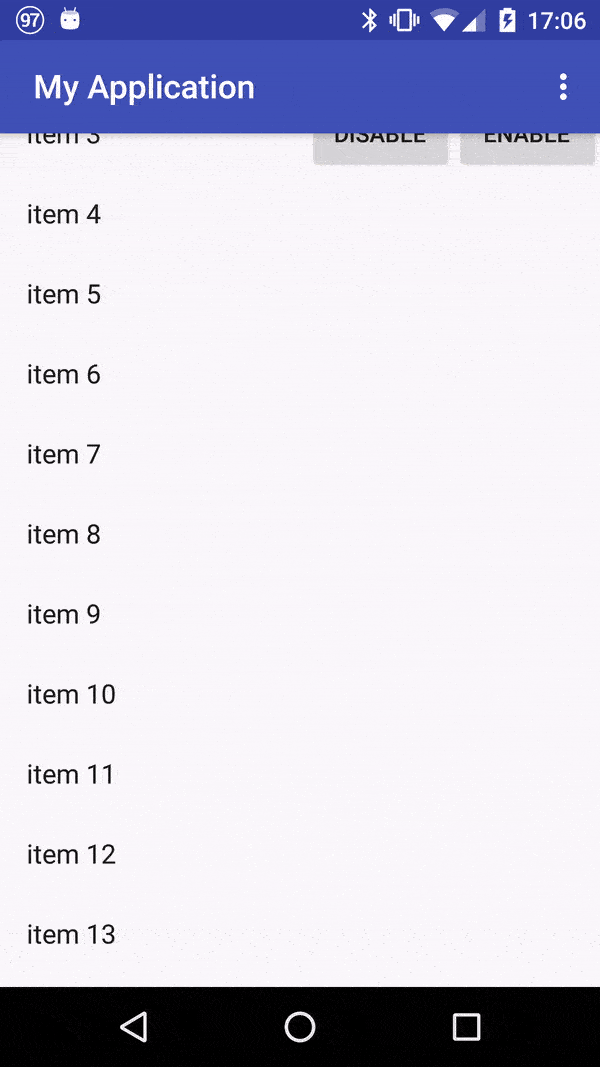背景
我们的布局相当复杂,其中包含CollapsingToolbarLayout和底部的RecyclerView。
在某些情况下,我们通过调用RecyclerView上的setNestedScrollingEnabled(boolean)方法来暂时禁用CollapsingToolbarLayout的展开/折叠功能。
问题
通常情况下这样做没问题。
然而,在一些(比较罕见的)情况下,RecyclerView缓慢滚动会出现卡顿,意味着在向下滚动时它会试图向后滚动。就像有两个滚动方向相互斗争:向上滚动和向下滚动。
触发此问题的代码如下:
res/layout/activity_scrolling.xml
<android.support.design.widget.CoordinatorLayout
xmlns:android="http://schemas.android.com/apk/res/android"
xmlns:app="http://schemas.android.com/apk/res-auto"
xmlns:tools="http://schemas.android.com/tools"
android:layout_width="match_parent"
android:layout_height="match_parent"
android:fitsSystemWindows="true"
tools:context="com.example.user.myapplication.ScrollingActivity">
<android.support.design.widget.AppBarLayout
android:id="@+id/app_bar"
android:layout_width="match_parent"
android:layout_height="@dimen/app_bar_height"
android:fitsSystemWindows="true"
android:theme="@style/AppTheme.AppBarOverlay">
<android.support.design.widget.CollapsingToolbarLayout
android:id="@+id/toolbar_layout"
android:layout_width="match_parent"
android:layout_height="match_parent"
android:fitsSystemWindows="true"
app:contentScrim="?attr/colorPrimary"
app:layout_scrollFlags="scroll|exitUntilCollapsed|snap">
<android.support.v7.widget.Toolbar
android:id="@+id/toolbar"
android:layout_width="match_parent"
android:layout_height="?attr/actionBarSize"
app:layout_collapseMode="pin"
app:popupTheme="@style/AppTheme.PopupOverlay"/>
</android.support.design.widget.CollapsingToolbarLayout>
</android.support.design.widget.AppBarLayout>
<android.support.v7.widget.RecyclerView
android:id="@+id/nestedView"
android:layout_width="match_parent"
android:layout_height="match_parent"
app:layout_behavior="@string/appbar_scrolling_view_behavior"/>
<LinearLayout
android:layout_width="wrap_content"
android:layout_height="wrap_content"
android:orientation="horizontal"
app:layout_anchor="@id/app_bar"
app:layout_anchorGravity="bottom|end">
<Button
android:id="@+id/disableNestedScrollingButton"
android:layout_width="wrap_content"
android:layout_height="wrap_content"
android:text="disable"/>
<Button
android:id="@+id/enableNestedScrollingButton"
android:layout_width="wrap_content"
android:layout_height="wrap_content"
android:text="enable"
/>
</LinearLayout>
</android.support.design.widget.CoordinatorLayout>
ScrollingActivity.java
public class ScrollingActivity extends AppCompatActivity {
@Override
protected void onCreate(Bundle savedInstanceState) {
super.onCreate(savedInstanceState);
setContentView(R.layout.activity_scrolling);
Toolbar toolbar = (Toolbar) findViewById(R.id.toolbar);
setSupportActionBar(toolbar);
final RecyclerView nestedView = (RecyclerView) findViewById(R.id.nestedView);
findViewById(R.id.disableNestedScrollingButton).setOnClickListener(new OnClickListener() {
@Override
public void onClick(final View v) {
nestedView.setNestedScrollingEnabled(false);
}
});
findViewById(R.id.enableNestedScrollingButton).setOnClickListener(new OnClickListener() {
@Override
public void onClick(final View v) {
nestedView.setNestedScrollingEnabled(true);
}
});
nestedView.setLayoutManager(new LinearLayoutManager(this));
nestedView.setAdapter(new Adapter() {
@Override
public ViewHolder onCreateViewHolder(final ViewGroup parent, final int viewType) {
return new ViewHolder(LayoutInflater.from(parent.getContext()).inflate(
android.R.layout.simple_list_item_1,
parent,
false)) {
};
}
@Override
public void onBindViewHolder(final ViewHolder holder, final int position) {
((TextView) holder.itemView.findViewById(android.R.id.text1)).setText("item " + position);
}
@Override
public int getItemCount() {
return 100;
}
});
}
}
我尝试过的
一开始,我认为这是因为其他原因(我认为它与DrawerLayout的奇怪组合有关),但后来我找到了一个最小的示例来展示它,结果正如我所想:这完全是由于setNestedScrollingEnabled引起的。
我试图在Google网站上报告此问题(此处),希望如果这是真正的bug,就会得到修复。如果您想要尝试或观看该问题的视频,请前往上述网址,因为我无法在此处上传所有文件(太大且文件太多)。
我还尝试按其他帖子中的说明使用特殊标志(例如:此处、此处、此处、此处和此处),但没有帮助。实际上,每个标志都有问题,无论是保持扩展模式还是以与我不同的方式滚动。
问题
这是一个已知的问题吗?为什么会发生这种情况?
有没有办法克服这个问题?
是否有其他方法调用setNestedScrollingEnabled函数而不会有任何滚动问题或锁定CollapsingToolbarLayout状态的替代方案?
